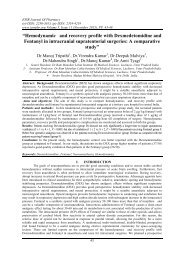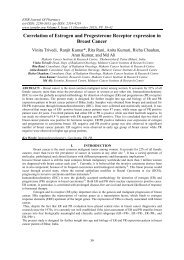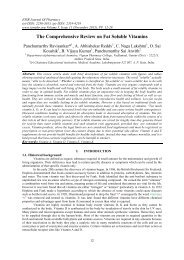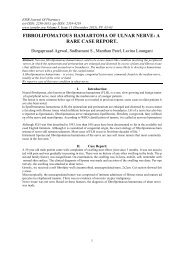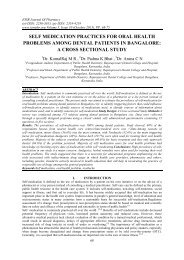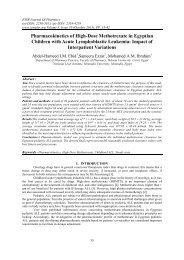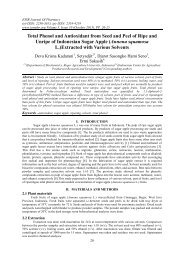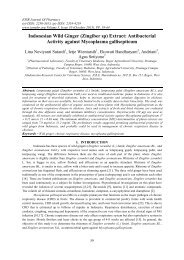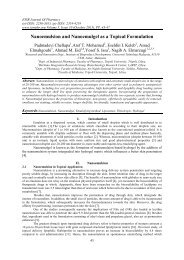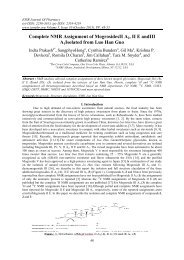Sulphasalazine Induced Toxic Epidermal Necrolysis A Case Report
Toxic Epidermal Necrolysis (TEN) is a rare and life threatening mucocutaneous reaction characterized by extensive necrosis and detachment of epidermis. The Worldwide incidence of TEN is 0.9 to 1.4 per million populations per year [1]. Here we have discussed a case of Toxic Epidermal Necrolysis secondary to Sulfasalazine managed with fluid replacement, analgesics, anti-infective therapy aggressive nutritional support and intravenous high dose steroid therapy. Keywords- Toxic Epidermal Necrolysis, Sulfasalazine
Toxic Epidermal Necrolysis (TEN) is a rare and life threatening mucocutaneous reaction
characterized by extensive necrosis and detachment of epidermis. The Worldwide incidence of TEN is 0.9 to 1.4
per million populations per year [1]. Here we have discussed a case of Toxic Epidermal Necrolysis secondary
to Sulfasalazine managed with fluid replacement, analgesics, anti-infective therapy aggressive nutritional
support and intravenous high dose steroid therapy.
Keywords- Toxic Epidermal Necrolysis, Sulfasalazine
You also want an ePaper? Increase the reach of your titles
YUMPU automatically turns print PDFs into web optimized ePapers that Google loves.
IOSR Journal Of Pharmacy<br />
(e)-ISSN: 2250-3013, (p)-ISSN: 2319-4219<br />
www.iosrphr.org Volume 5, Issue 11 (November 2015), PP. 09-11<br />
<strong>Sulphasalazine</strong> <strong>Induced</strong> <strong>Toxic</strong> <strong>Epidermal</strong> <strong>Necrolysis</strong> A <strong>Case</strong><br />
<strong>Report</strong><br />
Dr. N. Asvini 1 , Dr. K.Vasanthira 2<br />
1 Assistant Professor, 2 Prof and HOD, Department of Pharmacology, Government Stanley Medical College,<br />
Chennai, Tamilnadu<br />
Abstract: <strong>Toxic</strong> <strong>Epidermal</strong> <strong>Necrolysis</strong> (TEN) is a rare and life threatening mucocutaneous reaction<br />
characterized by extensive necrosis and detachment of epidermis. The Worldwide incidence of TEN is 0.9 to 1.4<br />
per million populations per year [1]. Here we have discussed a case of <strong>Toxic</strong> <strong>Epidermal</strong> <strong>Necrolysis</strong> secondary<br />
to Sulfasalazine managed with fluid replacement, analgesics, anti-infective therapy aggressive nutritional<br />
support and intravenous high dose steroid therapy.<br />
Keywords- <strong>Toxic</strong> <strong>Epidermal</strong> <strong>Necrolysis</strong>, Sulfasalazine<br />
I. Introduction<br />
Drug induced toxic epidermal necrolysis is a rare, potentially lethal disease characterized by extensive sheet like<br />
erosions involving more than 30% of the body surface with widespread purpuric macules or flat atypical target<br />
lesions and severe involvement of conjunctival, corneal, irideal, buccal, labial and genital mucous membranes.<br />
Commonly involved drugs are antibiotics, anti-inflammatory drugs, anticonvulsants, antiretroviral drugs. The<br />
principle management of TEN includes analgesia, fluid replacement, anti infectious therapy, aggressive<br />
nutritional support, warming of external temperature and skin care with dressings.<br />
II. <strong>Case</strong> <strong>Report</strong><br />
An 18 years old girl presented to the casualty with presenting complaints of oral and genital ulcerations<br />
and erosions over whole of the body of four days duration. She developed oral and genital ulcerations which<br />
rapidly progressed to cutaneous lesions over the back, which later spread to involve the chest, face, arms and<br />
legs. Blisters increased in size and joined to form erosions which coalesced and lead to epidermal detachment<br />
over the chest, abdomen and thighs. She had history of difficulty in vision and genital ulceration.<br />
She was the born of non consanguinous marriage. She was normal until 15 yrs of age, then developed<br />
difficulty in walking Investigated and started on at since 21-12-2010 for 6 months. She had normal<br />
developmental milestones, attained menarche at 13 years of age and had normal menstrual cycles. No history of<br />
similar skin problems in the family. She had ankylosing spondylitis for which she was started on tablet<br />
sulfasalazine 500 mg od for 3 days then gradually raised to 2g/day for 2 months.<br />
On examination she was thinly built and poorly nourished. Her pulse rate was 88 per minute and blood<br />
pressure 90/50 mmHg. She had confluent erosions and peeling of skin over the multiple large necrotic skin<br />
lesions seen over the Chest, Proximal arms, Abdomen and Thigh. Large areas of exuding dermis were seen over<br />
Back, face and neck. Extensive erosions and necrosis of Lower Lip and Oral Mucosa seen [Fig: 1], In Eye,<br />
Purulent conjunctivitis, Synechiae between eyelids and Shedding of eye lashes were seen. Blisters were seen in<br />
Palms and soles. Maculopapular lesions with central vesicle were seen over the Arms and Legs [Fig: 2].<br />
She was admitted in the intensive medical care unit and assessed further. A detailed drug history was taken<br />
and causality was assessed using Naranjos algorithm. The total score was 8 and the offending drug was probably<br />
Sulfasalazine. A diagnosis of <strong>Toxic</strong> epidermal necrolysis was made as more than 60 percentage of the body<br />
surface area was involved. Immediate intravenous access was obtained and she was managed with fluid<br />
replacement and saline dressings. High dose Dexamethasone was started given as intravenous injections of 8mg<br />
twice daily for 14 days which was rapidly tapered and stopped by 3 rd week and supportive care. Opthalmology<br />
and dental opinion was sought and her oral and eye lesions were managed accordingly. Her Scoreten score at<br />
third day of admission was 1 which carried a mortality rate of 3.2%. She improved well with high dose of<br />
corticosteroids and supportive care. The Dexamethasone injections were continued for two weeks after which it<br />
was slowly tapered and stopped by third week. At discharge her lesions resolved completely and there was only<br />
post inflammatory hypopigmentation [Fig: 3, 4].<br />
9
<strong>Sulphasalazine</strong> <strong>Induced</strong> <strong>Toxic</strong> <strong>Epidermal</strong> <strong>Necrolysis</strong> …<br />
III. Discussion<br />
Drug induced toxic epidermal necrolysis (Lyell’s syndrome) is a rare, potentially lethal disease<br />
characterized by extensive sheet like erosions involving more than 30% of the body surface with widespread<br />
purpuric macules or flat atypical target lesions and severe involvement of conjunctival, corneal, irideal, buccal,<br />
labial and genital mucous membranes . [2]. It was first described by a Scottish Dermatolgist Alan Lyell in<br />
1956[3]. He coined the term necrolysis by combining the key clinical feature epidermolysis with<br />
histopathological feature necrosis. There is also severe involvement of mucous membranes with a characteristic<br />
dermal silence [4].<br />
Majority of cases appear to be related to idiosyncratic drug reactions. Commonly involved drugs are:<br />
antibiotics such as sulfonamides, beta-lactams, tetracyclines and quinolones; anticonvulsants such as phenytoin,<br />
phenobarbital and carbamazapine; antiretroviral drugs; nonsteroidal anti-inflammatory drugs and allopurinol [5]<br />
Pharmacogenetic variations in metabolism of these drugs might be the possible reason as to why only few<br />
people develop such marked lesion against these medications. These genetic associations might be drug specific<br />
as evidenced by the occurrence of HLA B 1502 in DJS and TEN induced by carbamazepine[6]. Similarly the<br />
risk of cotrimoxazole induced TEN was found to be 3-11 fld higher in patients with hla b*15:02, hla c*06:02<br />
and hla c*08:01[7].<br />
Histopatholgically there is full thickness necrosis of the whole epidermis with very less dermal<br />
abnormality. The underlying pathology is extensive keratinocyte apoptosis mediated by the interaction between<br />
Fas ligand expressed by lymphocytes and fas antigen cd 95 expressed by keratinocytes.<br />
The principle management of TEN includes analgesia, fluid replacement, anti infectious therapy,<br />
aggressive nutritional support, warming of external temperature and skin care with dressings. There is no<br />
consensus about the disease specific therapy [8]. The high dose corticosteroid therapy reduces inflammation and<br />
keratinocyte necrosis [9]. But some studies show that it promotes or masks the signs of infection, delays healing<br />
and may increase mortality [10]. Treatment with oral or parentral steroids like dexamethasone 8-16 mg daily can<br />
be started within the first 72 hrs of onset of symptoms and continued for 3-5 days followed by rapid tapering.<br />
Studies have shown good results on treatment with cyclosporine [11].<br />
Cyclosporine in the dose of 3-5 mg/kg/day orally or intravenously for 4 weeks have been tried.<br />
Intravenus immunglobulins have also been tried [12]. Other proposed treatment modalities include<br />
cyclophosphamide, pentxyphylline, n acetyl cysteine and plasmapheresis.<br />
IV. Conclusion<br />
An eighteen year old female patient, who had taken Tab.<strong>Sulphasalazine</strong> 1000 mg /day for eight weeks<br />
for Ankylosing Spondylitis which progressed to <strong>Toxic</strong> epidermal <strong>Necrolysis</strong>. She was admitted in the Intensive<br />
care unit in Govt. Stanley medical college and Hospital and the presumptive causative drug was stopped. She<br />
improved with high dose dexamethasone and supportive care. She had no acute or chronic complications on<br />
follow up.<br />
Fig: 1 Necrotic skin lesions<br />
Fig: 2 Maculopapular lesions<br />
10
<strong>Sulphasalazine</strong> <strong>Induced</strong> <strong>Toxic</strong> <strong>Epidermal</strong> <strong>Necrolysis</strong> …<br />
Fig: 3 Fig: 4<br />
After Treatment - Post Inflammatory Hypopigmentation<br />
References<br />
[1]. R.G.Valia, Ameet R.Valia. IADVL textbook of dermatology 3 rd edition: Bhalani publishing home; Chapter 4.<br />
[2]. Tony burns, Stephen Breath nach, Neil Cox, Christopher Griffiths. Rook’s Textbook of dermatology 8 th ed. Wiley-Blackwell;<br />
Volume 4 Chapter 76; p.76.22.<br />
[3]. Lyell A. <strong>Toxic</strong> epidermal necrolysis: an eruption resembling scalding of the skin. Br. J. Dermatology. 1956; 68:355-361<br />
[4]. Achten G, Ledux-Corbusier M. Lyel’s toxic epidermal necrolysis: histological aspects. Arch. Belg. Dermatol. Syphiigr 1970;<br />
26:97-114.<br />
[5]. Klaus Wolff, Lowell A, Goldsmith, Stephen I Katz, Barbara A, Gilchrest Amy S, Paller, David J Leffell.Fitzpatrick’s<br />
Dermatology in General Medicine. 7 th ed. United States of America: McGraw –Hill Edition 2008: Chapter 39, p.349.<br />
[6]. Nguyen DV, Chu HC, Phan MH, Craig T,Baumgart K et al. HLA-B*1502 and carbamazepine – induced severe cutaneous<br />
reactions in Vietnamese. Asia Pac Allergy 2015 Apr 5(2):68-77<br />
[7]]. Kongpan T, Mahasirimongkol S, Konyoung P, Kanjana wart S, Chumworathayi P, Wichukchinda N et al. Candidate HLA genes<br />
for prediction of cotrimoxazole induced severe cutaneous reactions. 2015 Aug 25(8): 402-11<br />
[8]. Longo, Fauci, Kasper, Hauser, Jameson. Loscalzo. Harrison’s principles of internal medicine. 18 th ed. United States of America:<br />
McGraw –Hill Edition; Chapter 55, .p436<br />
[9]. Revuz J, Tpujeau J-C, Guillaume J-C et al. Treatment of toxic epidermal necrolysis: Creteil’s experience. Arch Dermatology<br />
1987; 123:1156-8.<br />
[10]. Roujeau J-C, Revuz J. Intensive care in dermatology. In: Champion RH, Pye RJ,eds. Recent Advances in Dermatology, vl 8.<br />
Edinburgh: Churchill Livingstone.<br />
[11]. Singh G K, Chatterjee M, Verma R. Cyclosporine in Steven Johnson syndrome and toxjic epidermal necrolysis and retrospective<br />
comparison with systemic corticosteroid. Indian Journal of Dermatology Venerology Leprology 2013 Sep- Oct: 79(5):686-92.<br />
[12]. Stella M,Clemente A, Bollero D,Risso D,Dalmasso P. <strong>Toxic</strong> epidermal necrolysis (TEN) and Stevens-Johnson syndrome (SJS):<br />
experience with high-dose intravenous immunoglobulins and topical conservative approach. A retrospective analysis Burns.2007<br />
Jun; 33(4):452-9.<br />
11




